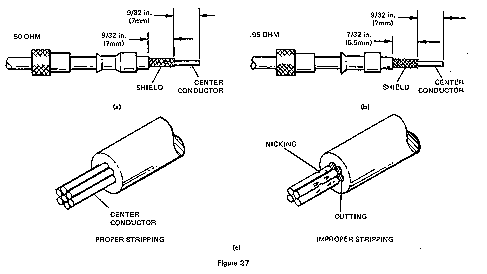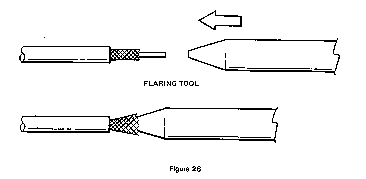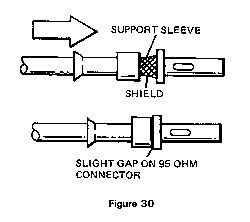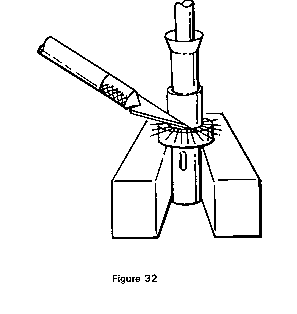Installation of Connectors – 50 and 95 Ohm Cables
1. Cut cable to exact length required. In the case of connector replacement on an existing cable, any alteration of the original physical length of the cable should be held to an absolute minimum.
2. In the case of plugs (male connectors), slip retaining nut and ferrule over the end of the cable, note orientation in (Figure 26). In the case of receptacles (female connectors) slip ferrule only over end of the cable.
3. Caution: When stripping cable, do not cut or nick the wires of the braided shield or center conductor. Strip cable end to dimensions as shown in Figures 27a and 27b for 50 ohm or 95 ohm cables, respectively. Figure 27c shows illustrations of proper and improper stripping operations.
4. Figure 28 shown performance of the flaring operation using a flaring tool. As noted, this flares the shield to an approximate 45 angle without destroying the braided configuration of the shield. (As mentioned earlier, this flaring operation can be performed without a flaring tool using a pointed, but not overly sharp tool as long as reasonable care is exercised to avoid destruction of the braided configuration of the outer shield). The flaring operation should be done prior to removal of the inter insulation.
5. Inspect flared wired to ensure that the sleeve to be installed in the following step will enter into the flared opening without snagging shield wires. Twist wires of the center conductor into a straight cable with wires twisted tightly to end. Inspect cable to ensure no shield or center conductor wires are damaged, as discussed above. (Center conductor has seven wires).
6. Slip plug or receptacle sleeve over cable dielectric. Rotate part slightly to aid inserting all wires of center conductor in center contact of plug or receptacle. All shield wires must be outside the sleeve. Push sleeve fully over dielectric. Excess shield wires will flare outward against shoulder of sleeve (refer to Figure 29).
7. Slide ferrule over shield braid and plug of receptacle sleeve until ferrule firmly presses excess shield wires against shoulder of sleeve (refer to Figure 30).
8. Be certain that ferrule and sleeve are assembled correctly per step 7 before crimping. Place connector assembly in die of crimping tool as shown (refer to Figures 31a and 31b). To prevent misalignment, position parts carefully and hold in position while closing dies. Be sure that the upper center contact crimping die enters the upper crimping hole as the dies are closed.
9. Support plug or receptacle and carefully trim excess shield wires flush with outside diameter of ferrule all around ferrule (refer to Figure 32). Protruding wires will jam connector threads.
10. Apply a small amount of Dow-Corning 3140 RTV Sealant on the crimping holes. Wipe off any excess RTV Sealant. Make sure excess RTV does not enter the connector causing intermittent connection.






